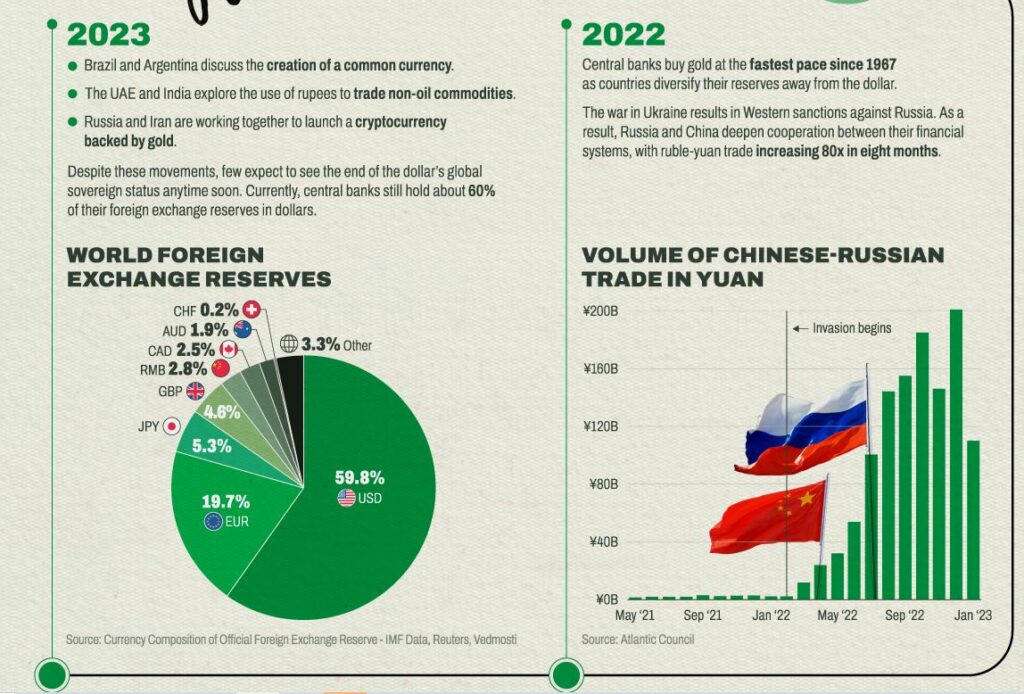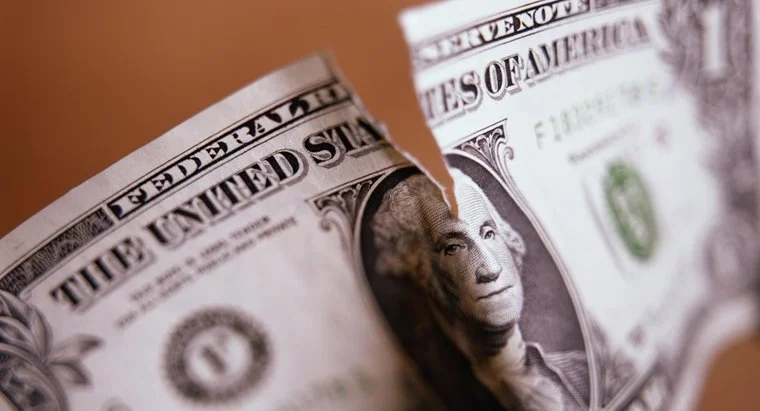YEREVAN (CoinChapter.com) – The US dollar has been a safe haven for the international economy for decades and currently holds nearly 60% of global foreign currency exchange reserves. However, the greenback’s sanctuary status is now threatened due to the growing de-dollarization. Here are the main reasons why.
#1 Federal Reserve’s monetary policy weakened the dollar.
The post-Covid economy faced various challenges, from supply bottlenecks and rising unemployment to Fed’s interest rate hikes due to runaway inflation. Moreover, the Fed’s determination to raise interest rates again in the coming quarter wobbled the dollar’s stability even further.
In detail, raising interest rates, albeit to fight inflation, risks recession which the Fed is not likely to avoid. Moreover, while the Fed policy aimed at addressing specific domestic requirements, the world currency basket.

The chart below tracks the dollar index (DXY), meaning dollar strength against Euro, Swiss Frank, Japanese Yen, Pound Sterling, etc. The greenback’s performance in 2023 was choppy, with a 3% decline since March 8, the day Silicon Valley Bank collapsed.
Quincy Krosby, the chief global strategist for LPL Financial, agreed that the Fed still has a long way to go, recalling that “it took them a long time to acknowledge that inflation was stickier than they initially assessed.”
This is not to criticize them but to understand: They do not know more about inflation than the average consumer. That’s important. It’s just that it’s their job to know. And that’s where the criticism comes in.
he added.
#2 Increasing de-dollarization globally
As mentioned, the greenback was a safe haven for the global economy. However, the dollar’s “King” status is in danger. The Association of Southeast Asian Nations, or ASEAN, established in 1967, reconsidered using the dollar as their trade currency.
In fact, during the latest meeting on March 28 in Indonesia, the Association did not regard the Euro or the Pound as an alternative to the dollar trades. Instead, the ASEAN Finance Ministers and Central Bank Governors moved for settlements in local currencies.
Moreover, the Local Currency Transaction (LCT) scheme also plans to move away from the western payment systems. Indonesian President Joko Widodo also urged regional administrations to start using credit cards issued by local banks.
He argued that Indonesia needed to shield itself from geopolitical disruptions, citing the sanctions targeting Russia’s financial sector from the US, EU, and their allies over the conflict in Ukraine. Moving away from Western payment systems is necessary to protect transactions from “possible geopolitical repercussions,” Widodo said.
Also read: Major Blow to US as Saudi Arabia Deepens Ties with China and Russia.
The tendency to de-dollarize international trade is not endemic to ASEAN. As the infographic below shows, countries like Brazil and Argentina also discuss the growing need for a common currency. At the same time, the volume of trade between Russia and China is carried out in the Chinese Yuan.

#3 Growing strength in the East
After the collapse of the Soviet Union, the global power distribution was no longer bipolar but rather skewed towards the North Atlantic Treaty Organization (NATO), which includes 28 European countries, Canada, and the US.
However, the de-dollarization also means that the US will no longer hold the power it has today. The growing strength East of NATO is a possibility of a new bi-polarization.
The China-US relations are in a shaky phase, considering the countries “chose” opposing sides in the war between Russia and Ukraine. Moreover, the latest spy balloon incidents have put additional strain on the situation.
Moreover, China completed its first liquid natural gas (LNG) trade in Yuan, as reported on March 28. Approximately 65,000 tonnes of LNG imported from the United Arab Emirates changed hands in the trade.
During a December visit to the Saudi capital Riyadh, Chinese Communist Party leader Xi Jinping announced that China would “make full use” of the Shanghai exchange as a platform to carry out yuan settlements of oil and gas trades.
As tides changed in the East, Saudi Arabia allied with the China-led “security block,” including Russia, India, Pakistan, and four other central Asian nations as full members. Meanwhile, Saudi Arabia, Qatar, and Turkey would be included in the nine “dialogue partner” countries.
Concerned about America’s dominance over the global financial system and its ability to “weaponize” it, other nations have been testing alternatives to reduce the dollar’s hegemony.
#4 US banking system collapse
After the Silicon Valley Bank collapsed, the Federal Reserve established an emergency loan program to save the depositors’ assets. However, the program could inject over $2 trillion in liquidity into the banking system.
“The Federal Reserve is prepared to address liquidity pressures that may arise,” stated the Fed, despite its ongoing battle to curb runaway inflation. The President himself praised his team for a timely response to the crisis.
Thanks to the quick action of my administration in the past few days, Americans can have confidence that the banking system is safe. Your deposits will be there when you need them.
.noted the President during a press conference.
Moreover, Biden asserted that not a dime would come from taxpayers’ pockets to “bail out SVB.”
Instead, some of the country’s most powerful banks, including JPMorgan Chase, Wells Fargo, Citigroup, and Truist, combined to shore up teetering First Republic Bank in a $30 billion cash infusion days after the Fed emergency loan guaranteed deposits in Silicon Valley Bank.
Also read: Fed regulator accuses Silicon Valley Bank of “terrible” risk management under Senate grilling.
However, according to Adam Cochran, the Vice President of Operations at SBT Partners, the worst is far from over.
He asserted that “consumer confidence is shaken” and more withdrawals are yet to come. “Banks are sitting praying that people don’t withdraw or that the Fed provides infinite liquidity against bad bets. Maybe it works. Maybe it doesn’t,” he said.
Cato institute estimates: “$1T-$2T of withdraws from US Banking in the next 12 months.” To contextualize, US commercial assets according to Fed is only $24T. So that’d be an 8% of all assets, or 12% of deposits.
said Cochran.
Minneapolis Fed President Neel Kashkari, a Federal Open Market Committee (FOMC) voter this year and an outspoken hawk, asserted that the US banking crisis only ignites recession fears. Notably, he did not comment on the upcoming FOMC meeting on May 3.
However, he emphasized how closely the Fed monitors the risks of a credit crunch.
#5 Dollar’s international safe haven status might be short-lived
In times of crisis, money often flows into the US dollar as investors seek refuge from trouble in other economies.
However, the dollar’s international safe-haven status is shaky due to all the reasons listed above, and the cracks started to run in 2014. After annexing Crimea, Russia and China shifted the paradigm away from the dollar trade.
All the factors considered, the dollar is not yet doomed. It’s still considered one of the most stable currencies worldwide. The demand for the dollar might still be strong, but the greenback will soon have some serious competition.
The post 5 reasons why the dollar is f*cked appeared first on CoinChapter.







